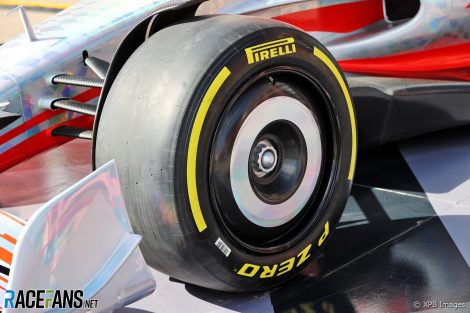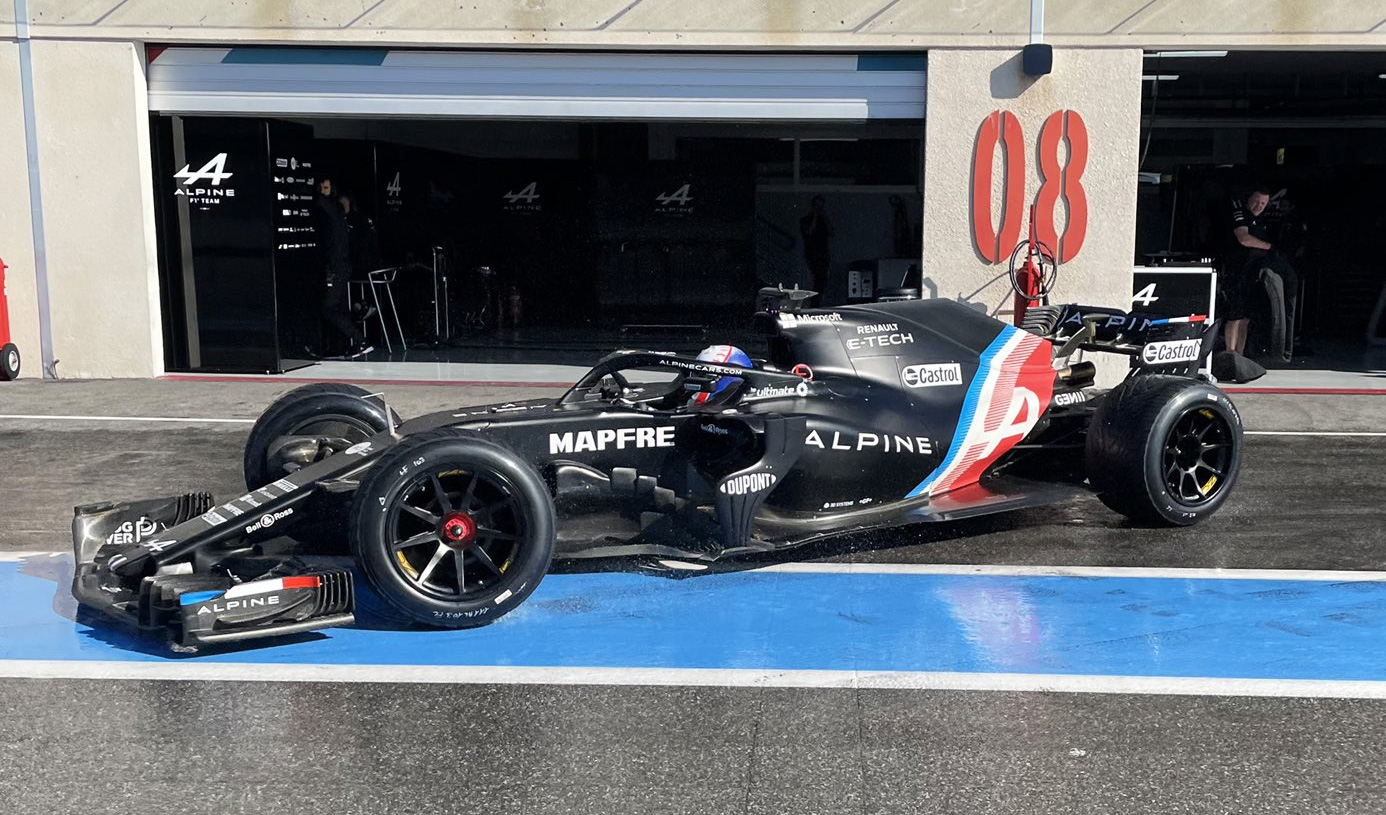Pirelli has completed testing of the new 18-inch tyres which will be introduced for the 2022 Formula 1 season.
Alpine test driver Daniil Kvyat covered the last of 36 days of track testing in France yesterday. The test at Paul Ricard was held in wet conditions.Most of Pirelli’s testing took place during 2021. A few days of running were completed in 2019 and 2020 before the introduction of the new rubber was delayed by a year due to the Covid-19 pandemic.
Pirelli has used 1,568 tyres – six lorry-loads – to cover 4,267 laps. It produced 70 virtual prototypes and 30 different physical examples to define the five new compounds and constructions which will be raced next year.
These were tested on 10 different circuits in a mixture of dry and wet conditions, covering more than 20,000 kilometres. Nine of the 10 teams participated. The exception was Williams, which decided not to go to the expense of producing a ‘mule car’ for the tests during its financial difficulties early last year.
One planned test was cancelled due to technical problems with Alpine’s car. Carlos Sainz Jnr refused to confirm reports he crashed during another test at Jerez in February.
Advert | Become a RaceFans supporter and
Mercedes pulled out of one test in May due to budget concerns after one of their chassis was damaged in the Emilia-Romagna Grand Prix. Ferrari took their place.

“With this latest wet test we finally close our development schedule for the new 18-inch tyres,” said Pirelli’s head of motorsport Mario Isola.
“Last year, the Covid-19 pandemic meant that we had to revise our test programme entirely, cancelling on-track testing to concentrate on simulation as well as virtual development and modelling. This system of virtual screening helped us optimise the number of physical prototypes produced and return to on-track testing for 28 days throughout 2021.”
Isola said it had been “vital” to gain the input from current drivers. The 18-inch tyres will be used for the final two days of testing at Yas Marina at the end of the year.
“Next year, we will still have some test days at our disposal, which will allow us to fine-tune the 2022 tyre with the new cars if needed,” said Isola. “Once the specification has been validated by the FIA, the drivers will have the chance to try out the definitive 18-inch tyres at the test after the Abu Dhabi Grand Prix, although we will have to wait for next year’s pre-season tests to see these tyres in action on the 2022 cars for the first time.”
Advert | Become a RaceFans supporter and
2022 F1 season
- Mercedes told me “you’re wrong” about 2022 car’s problems – Hamilton
- FIA confirms all 10 F1 teams complied with 2022 cost cap
- Steiner “not ashamed” of panning “slow” Schumacher in Drive to Survive
- Albon believes year out of F1 improved him as a driver
- Hamilton sees diversity gains in F1 years on from his ‘traumatising’ experience of racism





Gubstar
19th October 2021, 12:01
So they have tested over thousands of miles……. I wonder how many of those miles included riding/banging sausage kerbs et al, lap after lap. I wonder if teams will have to redesign the way their suspensions work to cope with no longer having the fat tyres doing all the work
Jere (@jerejj)
19th October 2021, 12:31
@Gubstar Fat, what do you mean? Tyre width remains unchanged in case you meant that.
TurboBT
19th October 2021, 14:24
He meant the height of the rubber on tyres, being now narrower than 13 inches, thus having less air.
drmouse (@drmouse)
20th October 2021, 8:25
Yes, there will be significant changes to the suspension to cope with the lower profile tyres and much greater unsprung weight.
Sensord4notbeingafanboi (@peartree)
19th October 2021, 12:36
on average that is 10.88 laps per set of tyres.
Ruben
19th October 2021, 12:47
So that’s as long as they will last then :)
someone or something
19th October 2021, 17:55
Yeah, they’re prototypes after all. They’re not all used like they would be in a normal race weekend*, but a lot of them were probably pulled from the car after a single or handful of laps in different scenarios to be cut up and analysed for their different stages of wear and chemical degradation. Longer runs are of course all-important, but less fundamental for the understanding of the tyre, so they tend to be outweighed by very short runs.
*For reference: The Mercedes drivers drove 294 laps throughout the Spanish GP weekend, which, divided by their tyre allocations (13 sets of dry tyres each) means that each set was used on average for 11.3 laps.
If anything, this hints at an unusually large share of long runs on the 2022 tyres.
Balue (@balue)
19th October 2021, 13:17
The 18-inch tyres look funny and oversized, but I bet in a year they will look perfect and the current 13″ ones odd.
theRealMax (@millionus)
19th October 2021, 14:43
Why don’t they test with the new wheel covers on. Surely this will change temperatures or some facet of the way the wheel works/functions. Seems a bit strange to me.
Markp
19th October 2021, 14:56
I always thought theres no performance reason for this change just better for the tyre companies marketing. The thing is with the wheel covers on it’s hard to tell they are 18 inch wheels and not the current 13 which defeats what I believe to be the primary reason for the change.
Robert
19th October 2021, 21:25
Well, considering the entire car is a mule and not actually one that will race with these tires, I think there are no way to get perfect data anyway. I’m sure they will have taken into account all sort of things that will be different with the real 2022 cars.
Sensord4notbeingafanboi (@peartree)
19th October 2021, 22:28
@millionus Fair point, makes a lot of sense. I guess they must have felt that doing so would just throw another variable into the mix.
gDog (@gdog)
19th October 2021, 16:08
The best thing about the new tyres is that the only “benefit” (hint: it’s not performance or road relevance) of switching to 18″ wheels is being completely lost due the wheel covers totally obscuring the fact that we’ve got “road relevant” low profile tyres.
Robert
19th October 2021, 21:48
I think it’s right to move to a larger wheel, but it still bugs me how absolutely ENORMOUS the new tires are. At 72cm they are as tall as a regular dining table! Imagine the turbulence behind those, on cars that are aiming to significantly reduce turbulence.
Suspensions will need to be reconfigured of course, but the entire car will be new anyway so no big deal. And apart from needing slightly more space inboard, that must be a positive for the engineers since they have no control of the “air-spring” that is the tire – but they do have control over springs and damper settings. They just need to get used to how it operates. Also, the difference in sidewall height is much smaller than most people seem to think, due to the simultaneous increase in overall tire size.
2021: 660mm tire on 13″ (330.2mm) wheel = 164.9mm sidewall height.
2022: 720mm tire on 18″ (457.2mm) wheel = 131.4mm sidewall height.
Wheel diameter: 38.5% increase.
Tire diameter: 9.1% increase.
Sidewall height: 18.5% reduction.
(Widths unchanged)
Robert
19th October 2021, 21:57
Correction, sidewall height reduction is 20.3%. Slipped on the calculator…
SteveR
19th October 2021, 23:26
All true. Also, with the greater wheel diameter there is more room for uprights and suspension connections; we might see more normal upper wishbone angles which could certainly aid in camber change in bump or roll.
Jimmi Cynic (@jimmi-cynic)
20th October 2021, 1:37
They do have a bigger ‘pimp my ride’ look or is that ‘plump my ride’… too bad they didn’t go full bling with LEDs and spinners.
Dan G (@dang)
20th October 2021, 13:21
Why was the tyre diameter increased?
SteveR
20th October 2021, 14:09
Because otherwise they would have had a ±102 mm (4 inch) sidewall……
Robert
20th October 2021, 17:18
On a 205 wide road tire that would still be a 50% profile, which isn’t actually that low by todays standards. Or, they could have gone to 17″ or 16″ with the same 660mm tire if they think they must have more give in the sidewall. But I guess bigger is always better…